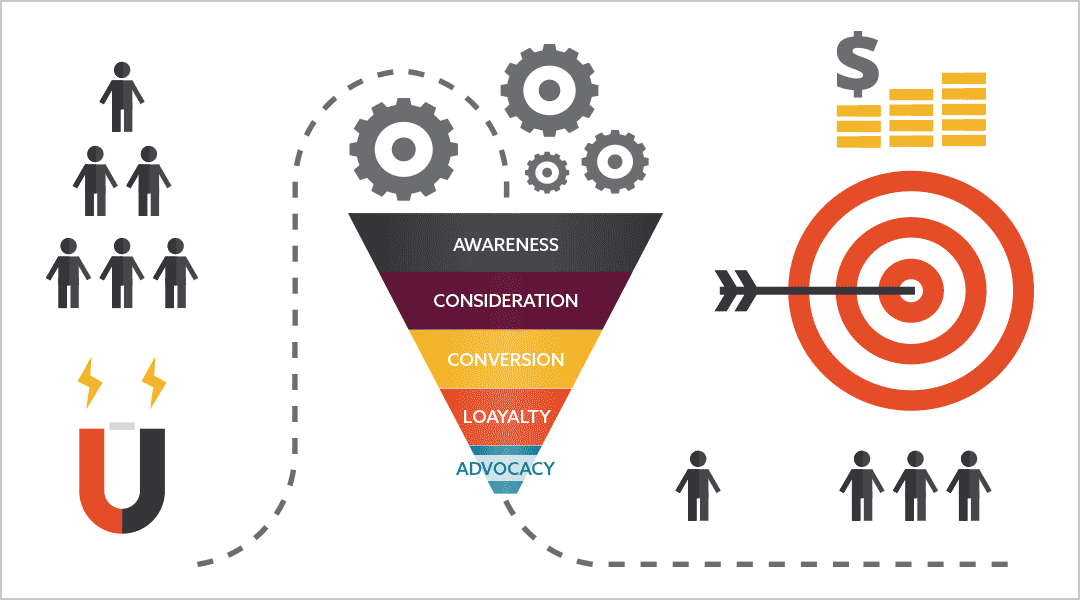OK, show of hands…who out there is using a marketing funnel to help establish their marketing objectives and to focus their marketing activities? We certainly hope all the hands went up, but we’re consistently amazed at how many marketing professionals don’t truly understand how marketing objectives (e.g., awareness, conversion, loyalty, etc.) may differ from overall business objectives (top line revenue, profit margin, etc.).
So we’re all on the same page, for reference, illustrated above is an example of a traditional funnel, which begins to help frame specific marketing objectives:
We frequently hear that it’s all about generating revenue, which is of course necessary to run a successful business, but what if few of your prospective customers have heard of your brand, or what if your prospective customers have heard of your brand but don’t have enough information (or the right information) to consider your brand when evaluating their options?
As an aside, we worked on a business with 98% brand awareness and only 8% consideration…what part of the funnel do you think we helped our client focus on?
And, if you already have a large customer base, isn’t it oftentimes more cost effective to try to increase sales among your current customers, rather than going about the expensive task of acquiring new ones? Or might you at least consider a mix of these two potential objectives in your marketing plan?
Understanding where your brand stands against each part of the funnel is critical to developing an effective marketing plan, with clear marketing objectives. And then developing the right strategies and tactics to achieve your marketing objectives. And note that these are very likely quite different than “sales objectives”.
For those of you new to the funnel concept, or if you just need a refresher, here’s a short overview of each funnel stage:
- Awareness: It’s pretty simple…customers can’t buy products they’re not aware of! To build awareness it’s important to understand where your target audience “lives” and where they’re open to consuming information about your brand and category. Do they spend a lot of time reading blogs or watching videos? Do they frequently drive on certain freeways/highways? Do they attend certain trade shows? This is important as you want to show your brand (through advertising, displays, etc.) where your customers are. And find the marketing vehicles that will allow you to maximize your reach for the lowest possible cost.
- Consideration: Just because prospective customers have heard of your brand, doesn’t mean they’d consider purchasing it. For example, they may not have enough information to make a decision (especially if it’s a high dollar purchase), they may not be aware of your brand’s unique differentiation, they may already, for whatever reason, have some negative perceptions about your brand or they may already be highly satisfied customers of your competitor’s brand. Determining what consideration issues are standing in your brand’s way is critical as this will drive your communication strategy and marketing tactics.
- Conversion: This is where the rubber meets the road, but FIRST you must define conversion for your brand or your particular marketing initiative. In e-commerce, this is relatively straightforward as conversion is generally defined by an on-line purchase. In the B2B space, it may not be so simple. It could be a sale, OR it could be generating a qualified lead, OR it could be getting a prospective customer to download a white paper from your website. Remember, if you don’t properly define what conversion means for your marketing efforts, you have no way of measuring the effectiveness or ROI of your marketing investment.
- Retention: Once you’ve done the hard part of acquiring a new customer, strategies must be put in place to retain, and potentially upsell them. Importantly, have you done all you can to optimize the overall customer experience? Are there any related products and/or services your current customers might be interested in? In these situations, we recommend segmenting your current customer base on meaningful criteria – products/services being used, length of time as a customer, $ value, etc. – and develop specific strategies for each segment.
- Advocacy: Now that you have a loyal customer base, its time to get them to do the marketing and selling for you! How do you get them talking about your brand? This is where testimonials on your website, Yelp reviews and referral programs can be powerful marketing tools to convince prospective customers to consider looking at your brand.
It’s also important to understand that where your brand is in the funnel may vary based on geography, or some other factors. For example, if your brand is well established in San Diego and you’re looking to expand to Phoenix, your marketing objectives in San Diego may be Retention and Advocacy, while the objectives in Phoenix may be Awareness and Consideration.
We hope this framework helps you understand that using the marketing funnel to inform your marketing objectives, strategies and tactics will lead to a stronger, more targeted marketing effort; and it will help the organization understand marketing’s role in driving customer behavior and supporting the overall business goals.
Please share your stories or how using the marketing funnel helped you better focus your marketing efforts, and feel free to contact us if you have any questions.


Recent Comments